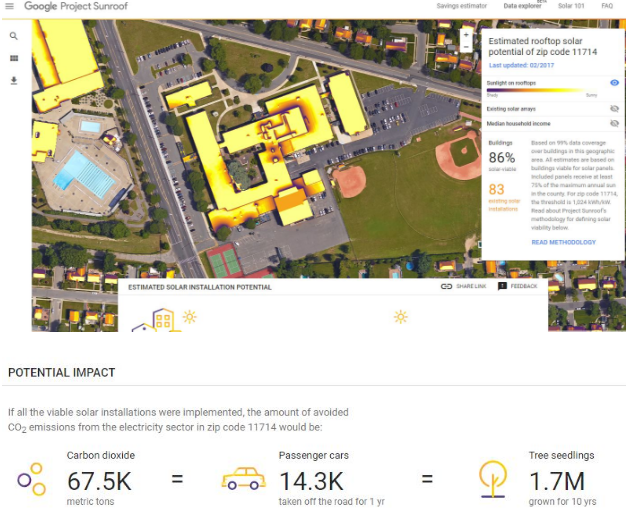Should Bethpage Implement Clean, Solar Energy?
Companies, schools, and organizations across the country have converted to using renewable energy. Seeing this increase of popularity has many thinking— what would happen if BHS used solar energy?
When the public thinks about solar energy, they think of expensive, bulky panels sitting on a roof. Administrators may also have concerns that panels cost way too much to ever be paid off. SUNation, a solar company based in Ronkonkoma, wants to prove them wrong. On their “Myth Vs. Fact” handout, they claim that “homeowners [can] go solar with ZERO out of pocket cost” and eventually “save upwards of $100,000.”
Let’s picture our high school: with a roof spanning 175,000 sq. ft., it has a major potential for absorbing as much sunlight as possible. According to representatives at Empower Solar, solar panels produce 22 watts of energy per square foot. Additionally, each watt of energy costs $3.50 to purchase from the energy company. This fee also includes the cost of tilted supports, which would help to drain the water after it rains. If you do the math, each panel totals $77.00.
In total, if BHS decided to install panels on each square foot of the roof, it would cost $14,437,500. That is a lot of money. However, it is not necessary to put panels on the whole roof. If BHS decided to install panels on just 25,000 square feet, it would cost $1,925,000, saving almost $12 million. It may seem like a lot of money, but the savings could pay for themselves over time.
There is another way that the cost of panels can be reduced. BHS can enter a power purchase agreement, or PPA, and pay no out-of-pocket costs. BHS could install panels on the whole roof, but they would just have to buy the energy that they are producing back from the energy company. Although we still have to pay for something, the cost of energy from a PPA is less than the cost of energy in a typical gas or electric energy bill. According to Energy Sage’s solar savings calculator, a PPA would have “immediate payback” and would save $1,478,000 over 20 years.
If consumers don’t believe the facts, they can take a look at these images and statistics provided by Google’s Project Sunroof. Google used satellite images to determine how effective solar panels would be on a specific roof. Bethpage High School’s roof stands out from the rest of the surrounding buildings, brightly colored neon yellow. According to the scale, the brighter the yellow, the more sunlight hits the roof. Bethpage High School’s roof possesses optimal conditions for light absorption.
And that’s not all. If every building and home in Bethpage utilized solar panels, 67.5 thousand metric tons of carbon dioxide would be immediately taken out of the atmosphere. This amount can be compared to the emissions of 14,300 cars that would be taken off the streets. This would drastically help not only our air quality, but our environment in general.
Bethpage has set an example for schools across Long Island for years. With their use of Chromebooks in the classroom, Bethpage led the technological way for other school districts. If Bethpage started the clean-energy trend, it’s likely that other schools would follow a precedent to implement solar panels as well. We could be the start of the solar energy wave across Long Island.
One business in particular has become the perfect example of a world switching over to renewable energy. Brinkmann’s True Value Hardware, with multiple locations scattered across Long Island, has become the first “net-zero” retailer in the United States. A “net-zero” retailer is a business that produces more energy than it needs and therefore has zero energy costs.
Not only does Brinkmann’s use solar panels, they also feature a thermoplastic cool roof on their flagship location in Sayville. This covering reflects the sun’s rays and cools off the building in the process. Their roof is an example of natural air conditioning–so why aren’t roofs like these being installed all over both the country and world?
On the whole, it all comes down to the savings. According to Ben Brinkmann, an owner of this business, their company saves “about $3.50 a square foot by operating at Net-Zero.” With large stores and multiple locations, Mr. Brinkmann believes that “with these energy cost savings, the additional upfront building expenses pay for themselves in about four years.” These numbers and predictions are incredible- can you imagine yourself not paying a single penny on energy bills?
However, solar energy isn’t all butterflies and rainbows. Bethpage has even tried going solar before–but to no avail.
According to John Keelan, head custodian here at BHS, there were a few panels installed in the new wing a few years back. Due to our flat roof, water started to build up and damage the panels. The project went downhill from there. Currently, only cinderblocks and black vinyl tubes sit up on the roof. This project just “didn’t work out,” according to Mr. Keelan.
Although this attempt failed, solar has come a long way, and BHS can learn from its mistakes. We can build tilted supports for the panels in the direction of the most sunlight. These supports would capture the most sunlight while preventing water from building up and damaging the panels.
It is obvious that solar panels can change the way that Bethpage thinks about energy. Our culture is slowly changing from gas-guzzling and wasteful to renewable-energy-loving and environmentally-friendly. Where do you stand?

Mia is a sophomore and this is her first year reporting for the Eagle’s Cry. She is looking forward to writing for the student body at Bethpage High...






